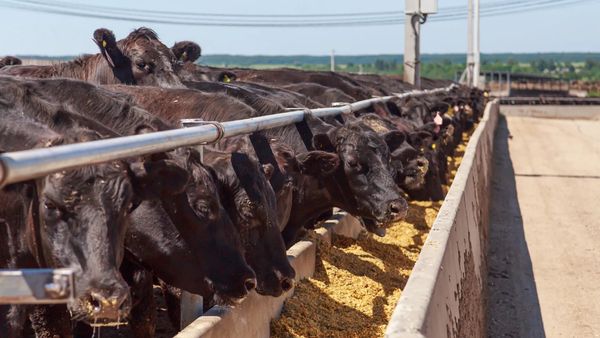.png?fit=outside&w=1600&h=900)
July 1 Cattle on Feed Up 1% From Year Ago
July 19, 2024
Cattle and calves on feed for the slaughter market in the United States for feedlots with capacity of 1,000 or more head totaled 11.3 million head on July 1, 2024. The inventory was 1% above July 1, 2023, USDA NASS reported on Friday.
The inventory included 6.82 million steers and steer calves, up 1% from the previous year. This group accounted for 60% of the total inventory. Heifers and heifer calves accounted for 4.48 million head, up slightly from 2023.
Placements in feedlots during June totaled 1.56 million head, 7% below 2023. Net placements were 1.51 million head. During June, placements of cattle and calves weighing less than 600 pounds were 365,000 head, 600-699 pounds were 255,000 head, 700-799 pounds were 350,000 head, 800-899 pounds were 349,000 head, 900-999 pounds were 165,000 head, and 1,000 pounds and greater were 80,000 head.
Marketings of fed cattle during June totaled 1.79 million head, 9% below 2023. Marketings were the second lowest for June since the series began in 1996.
Other disappearance totaled 57,000 head during June, 17% below 2023.
DTN ANALYSIS
"Friday's Cattle on Feed report came out almost identical to what analysts' pre-report projections were, other than in the placement category, which came in 3.4 percentage points less than originally expected," said DTN Livestock Analyst ShayLe Stewart.
"There are two likely ways in which Monday's market could react to Friday's Cattle on Feed report," Stewart said. "On the one hand, traders could find the report to be neutral given that pre-report estimates were nearly perfect and given that the market had traded cautiously throughout the week in preparation for the report, which was expected to showcase higher on-feed totals and weaker marketings, like it did. But reason and logic don't always win, and there's still a chance that the report could be found to be somewhat bearish given that on-feed totals have been confirmed to be higher than a year ago and that marketings have softened compared to a year ago. Regardless of how traders react on Monday, there wasn't anything outlandish in the report that should cause traders to react to the document for more than a day or two at the longest.
"In terms of the on-feed data, it comes as no surprise to anyone that in our current situation where packers are struggling to keep margins positive, on-feed totals have grown as packers are reducing slaughter speeds to slow up the cash cattle market. This week's slaughter is evidence of just that, as the week's total slaughter is only estimated at 584,000 head, which is 17,000 head less than a week ago and 41,000 head less than a year ago. Until consumer demand perks back up, which historically has been when temperatures cool around Labor Day, the market could see this trend of slower chain speeds as packers fear being at the mercy of the cash cattle market at a time when smaller calf crops are the norm.
"Secondly, it was relieving to see the report's placement lighter than a year ago. Last month we saw feeder cattle placements up 4%, which caught the market off guard. But with historically higher feeder cattle prices, cattlemen have been eager to market their calves while the industry's prices are strong. But from an input/output perspective, Friday's report solidifies the fact that, yes, more feeders were marketed early this year than normal. The only states that saw feeder cattle placements increase compared to a year ago were Colorado (up 11%), Idaho (up 3%), South Dakota (up 9%) and Washington (up 8%).
"In conclusion, I find Friday's Cattle on Feed report to be neutral given that the report showcased nothing that wasn't already known," Stewart said.
Source: DTN, ShayLe Stewart










